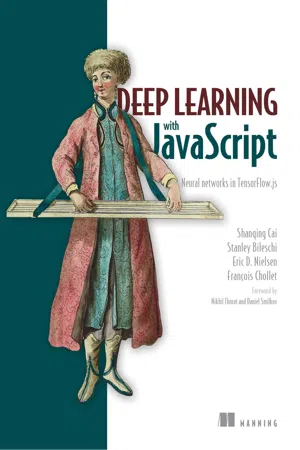
Deep Learning with JavaScript
Neural networks in TensorFlow.js
- 560 pages
- English
- ePUB (mobile friendly)
- Available on iOS & Android
Deep Learning with JavaScript
Neural networks in TensorFlow.js
About This Book
Summary Deep learning has transformed the fields of computer vision, image processing, and natural language applications. Thanks to TensorFlow.js, now JavaScript developers can build deep learning apps without relying on Python or R. Deep Learning with JavaScript shows developers how they can bring DL technology to the web. Written by the main authors of the TensorFlow library, this new book provides fascinating use cases and in-depth instruction for deep learning apps in JavaScript in your browser or on Node.Foreword by Nikhil Thorat and Daniel Smilkov. About the technology Running deep learning applications in the browser or on Node-based backends opens up exciting possibilities for smart web applications. With the TensorFlow.js library, you build and train deep learning models with JavaScript. Offering uncompromising production-quality scalability, modularity, and responsiveness, TensorFlow.js really shines for its portability. Its models run anywhere JavaScript runs, pushing ML farther up the application stack. About the book In Deep Learning with JavaScript, you'll learn to use TensorFlow.js to build deep learning models that run directly in the browser. This fast-paced book, written by Google engineers, is practical, engaging, and easy to follow. Through diverse examples featuring text analysis, speech processing, image recognition, and self-learning game AI, you'll master all the basics of deep learning and explore advanced concepts, like retraining existing models for transfer learning and image generation. What's inside - Image and language processing in the browser
- Tuning ML models with client-side data
- Text and image creation with generative deep learning
- Source code samples to test and modify About the reader For JavaScript programmers interested in deep learning. About the author Shanging Cai, Stanley Bileschi and Eric D. Nielsen are software engineers with experience on the Google Brain team, and were crucial to the development of the high-level API of TensorFlow.js. This book is based in part on the classic, Deep Learning with Python by François Chollet. TOC: PART 1 - MOTIVATION AND BASIC CONCEPTS 1 • Deep learning and JavaScript PART 2 - A GENTLE INTRODUCTION TO TENSORFLOW.JS 2 • Getting started: Simple linear regression in TensorFlow.js 3 • Adding nonlinearity: Beyond weighted sums 4 • Recognizing images and sounds using convnets 5 • Transfer learning: Reusing pretrained neural networks PART 3 - ADVANCED DEEP LEARNING WITH TENSORFLOW.JS 6 • Working with data 7 • Visualizing data and models 8 • Underfitting, overfitting, and the universal workflow of machine learning 9 • Deep learning for sequences and text 10 • Generative deep learning 11 • Basics of deep reinforcement learning PART 4 - SUMMARY AND CLOSING WORDS 12 • Testing, optimizing, and deploying models 13 • Summary, conclusions, and beyond
Frequently asked questions
Information
Table of contents
- Copyright
- Brief Table of Contents
- Table of Contents
- Foreword
- Preface
- Acknowledgments
- About this Book
- About the Authors
- About the cover illustration
- Part 1. Motivation and basic concepts
- Part 2. A gentle introduction to TensorFlow.js
- Part 3. Advanced deep learning with TensorFlow.js
- Part 4. Summary and closing words
- Appendix A. Installing tfjs-node-gpu and its dependencies
- Appendix B. A quick tutorial of tensors and operations in TensorFlow.js
- Glossary
- Index
- List of Figures
- List of Tables
- List of Listings